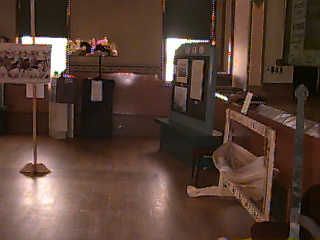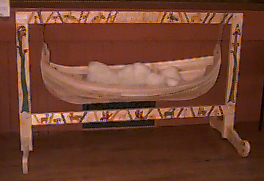



David has been interested in Norse culture for many years, from his research has grown a respect and admiration for Norse art-styles and modes of production. This fascination has been reflected in his art. Over the past ten plus years he has produced pieces flavored by Norse art styles and reproduction pieces. He has explored a variety of media including wood, metal, leather, stone, and antler.
His work has been shown at the Peterborough Centennial Museum, The Perry Sound Museum, The Wood Stock museum, and on History Televison's "History Lands". Most recently his efforts as an artist have been concentrated on antler carving - and fatherhood.

When I found out that I was going to be a father I was inspired to create this work as a cradle. Intended to serve hold my daughter and as a toy, this may be modified at a later date to work as a rocking seat. The title is a traditional Islandic greeting meaning 'you come blessed'. The 'knarr' was a type of norse ship. Shorter and wider than a longship, they were ideal as cargo vessels. It is was just such a knarr style ship that brought Leif Erikson to the new world.
Inspired by many period examples, specifically modeled after a tenth Century comb from York. Made from local materials this composite antler comb and case is riveted together with small steel pins. This is a functional and decorative piece. Contrary to popular perception, the Norse were well known in their time for being well groomed. A comb like this would have been an indispensable part of a Norse person's personal effects.
A.G. is an artist and book illustrator living and working in Windsor and Nobel, Ontario. Many of his books deal with history and early technology. He is also an amateur boatbuilder and sailor. Among his efforts are a Welsh coracle, a punt, and a seventeen foot Norwegian double- ended fishing boat featuring a square sail.

In 1990, while walking near a wheat field near the village of Lejre in Denmark, I picked up a handful of wheat heads and put them in a bag. On returning to Canada, I found them and wondered if they would grow. They did, and for the next three years, I replanted my small harvest.
Darrell has long been interested in ancient artifacts, historical techniques, and how materials, process and the role of the artisan blend in traditional European cultures. While a student at the Ontario College of Art in the late 1970's, he began his lifelong study of early Medieval material culture - and picked up the blacksmith's hammer for the first time. This combination of artifact knowledge and traditional skills would lead him to work in 'living history' programs : he developed the 'Norse Encampment' for L'Anse aux Meadows NHS and consulted on the major exhibits : 'Vikings - North Atlantic Saga' and 'Full Circle - First Contact' As an artist, Darrell has been long drawn to the sinuous curves in forged metals seen in the 'Art Nouveau' style.
"The Conquest marks one of those periods of major cultural upheaval that has always resulted in a huge blending and generation of artistic styles. The Normans imposed a layer of continental French style onto England, even though they were hardly two generations removed from their 'Viking' roots. England itself was a blend of cultures from earlier invaders - Norse from eight and nine hundreds and Saxons from the five and six hundreds. All this was laid on a more ancient Celtic and Pictish base. For the contemporary artist with a historic bent, this cauldron of styles is a rich source of inspiration" (Darrell is a member of An Droichead, as well as Curator of 'Reflections of the Conquest'.)

This piece was directly taken from the groupings of mounted Normans seen in several places along the Tapestry. Considering the 'cartoon like' outlines of the embroidery, I decided to stick with simple outlines - rather than detail and texture the metal sheet. The use of copper, brass and painted steel echoes the dominant colours from the original.
The Saxons derived their name from their word for knife - "seax", pronounced 'SAX'. They favoured a distinctive blade shape, with a long straight edge, slight widening towards the tip, and diagonal line to the point. 'Scrameax' means literally 'short knife', and small tool knives like this one where commonly worn by almost everyone. The blade is made using the pattern welding technique, a method perfected by the Saxons and widely used by the Vikings. In this blade, there are over 1000 individual layers of different steels forming the material of the blade.
The form of this large log holder was taken from an Early Medieval artifact from England (seen on a TV documentary!). The Normans were largely responsible for introducing the building of stone 'keeps' into England. A huge number sprang up immediately after the Conquest as they took control of their new holdings. They would hardly have been comfortable accommendations, the large spaces defined by the stone walls heated only by open fires in the middle of the floor. Large andirons like this one would have served to support the logs as they burned. As a a further reflection of the theme, the main bar is worked in punch work showing mounted Normans on one side and Saxon foot soldiers on the other.
As an artist, Laura walks between the worlds of fine and folk art, utilizing traditional iconography in some very contemporary contexts. The inspiration for her work comes from the Celtic traditions in music, dance and the visual arts which she has studied extensively for more than twenty years. She works primarily in limestone, soapstone, and slate. A recent large scale project is the site specific installation and garden, The Grove, at the Blackstone River Theatre in Cumberland, Rhode Island; she’s also shown her work in Providence, Maryland, Toronto, Worcester and New Bedford. She is an art teacher at an urban public school, holds an MFA in sculpture from the Maryland Institute College of Art, and lives in Rhode Island, where she maintains her studio at the unique downtown alternative arts center, AS220. (Laura is a member of An Droichead.)

As a sometime sailor who lives on the coast of Rhode Island, I naturally gravitated to the sailing vessels depicted in the Bayeux Tapestry. The very genesis of Britain as a great sea power is documented in the Tapestry, as we see the conquering Normans building the fleet, equipping and setting sail, and landing. Their open craft are clearly based on the longboats of their Viking forbears. One fascinating feature is that these boats "knocked down" for landing, with removable rigging, rudders and even figureheads. These deadly vessels seem fanciful to us now, with their archaic curved sails, their lines of shields at the rail, and their upturned stem and stern. For the piece, I've selected water-smoothed stones of colors that echo the colors used in the Tapestry, and set these wee ships on a platform of bog oak, hardened and blackened by a couple centuries in an Irish bog. A technology once deadly is now quaint, even charming, a tiny fleet for a mantlepiece.
